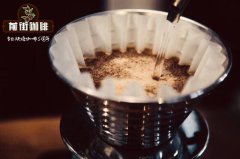How does the aroma of coffee beans come from? where does the aroma of coffee come from? why is it so fragrant?

Professional coffee knowledge exchange more coffee bean information please follow the coffee workshop (Wechat official account cafe_style)
Qianjie-introduction to flavor chemistry of coffee beans
Why do you love coffee so much? apart from the refreshing effects of caffeine, I think the reason why people and thousands of coffee fans often miss coffee is its charming aroma, so where does it come from? The important thing is that coffee beans are rich in a variety of raw materials, which produce a variety of reactions after baking, resulting in an attractive aroma. The two most important reactions are caramelization and Mena reaction. Let's take a look at what these two reactions are all about.
1. Caramelization reaction
The sugar in the coffee bean is caramelized at about 170-200 ℃, which is exactly the melting point of sucrose (185 ℃) and the temperature of the explosion stage when the coffee bean is roasted. The product of caramelization is divided into two parts:
(1) the dehydration product of sugar is caramel or sauce.
(2) the pyrolysis products are mainly volatile aldehydes and ketones.
Generally speaking, fire-roasted aroma, caramel and color are produced in the caramelization reaction, as well as other aromatic substances such as maltol, Cyclotene, furan and so on. These compounds can also be found in red wine, fruit juices, cream and other foods. However, if caramel is too much in the baking process is not a good thing, but will cause carbonization, making the coffee dry and choking. If the caramel is not enough, it will make the aroma monotonous and lack of layers.
two。 Mena reaction: Mena reaction can be divided into three stages
I. initial: carbonylamine condensation Amadori molecular rearrangement
Second, metaphase: Amadori molecular rearrangement product fructosamine is dehydrated to HMF (hydroxymethylfurfural), fructosamine is deaminated into reducing ketones, and amino acids interact with dicarbonyl compounds.
Third, the last stage: Aldol condensation to form melanin polymerization.
In addition to sugars, proteins account for about 11% of the weight of raw beans, and the amino acids contained in these proteins happen to be the raw materials needed for the Mena reaction. Mena reaction refers to amino acids and reducing sugars (glucose, fructose, lactose, etc.) in food. ) A series of reactions in the heating process. Mena reaction produces a variety of aromatic substances and pigments such as Pyridines, Pyrazines, Oxazoles, Thiazoles, Pyrroles. The Mena reaction plays an important role in the flavor of food cooking, whether it is the blackening and fragrance of the sausage when baking sausages, the soft roast chicken on the outside and the delicious baked bread. Mena reaction is responsible for the complete color, smell and flavor of these barbecue foods.
Coffee is blessed with a wide variety of complex chemicals, in addition to the above-mentioned compounds, there are other organic acids, inorganic acids, plant bases and so on. Not only sweet and beautiful ingredients, some slightly bitter compounds make coffee flavor have a wider level and change, together to create a unique rich taste of coffee.
Knowledge: melanoid, which is the product of Maillard reaction: the reaction between amino acids and carboxyl groups of reducing sugars, which are macromolecules, substances that turn coffee beans brown.
In short: Qianjie is a coffee research hall, happy to share the knowledge about coffee with you, we share unreservedly just to make more friends fall in love with coffee, and there will be three low-discount coffee activities every month. The reason is that Qianjie wants to make more friends drink the best coffee at the lowest price, which has been Qianjie's tenet for 6 years!
END
Important Notice :
前街咖啡 FrontStreet Coffee has moved to new addredd:
FrontStreet Coffee Address: 315,Donghua East Road,GuangZhou
Tel:020 38364473
- Prev

How does the aroma of coffee beans come from? what kind of substances does the aroma of coffee come from?
Professional coffee knowledge exchange more coffee bean information please follow the coffee workshop (Wechat official account cafe_style) Front Street-Coffee bean flavor substances non-volatile substances in coffee include: alkaloids (caffeine and trigonelline), chlorogenic acid, carboxylic acid, carbohydrates and polysaccharides, lipids, proteins, melanoids and minerals. Caffeine: it is soluble in water and will shadow.
- Next

The aroma of coffee is how it comes out. The rich aroma of coffee beans is technically fried.
Professional coffee knowledge exchange More coffee bean information Please pay attention to coffee workshop (Weixin Official Accounts cafe_style) Qianjie-coffee bean aroma source introduction Acid and sugar determine coffee flavor Acid affects coffee quality and complexity Coffee beans naturally contain some acids such as citric acid and malic acid and some acetic acid (which is decomposed or reacted by sugars and other compounds)
Related
- Beginners will see the "Coffee pull flower" guide!
- What is the difference between ice blog purified milk and ordinary milk coffee?
- Why is the Philippines the largest producer of crops in Liberia?
- For coffee extraction, should the fine powder be retained?
- How does extracted espresso fill pressed powder? How much strength does it take to press the powder?
- How to make jasmine cold extract coffee? Is the jasmine + latte good?
- Will this little toy really make the coffee taste better? How does Lily Drip affect coffee extraction?
- Will the action of slapping the filter cup also affect coffee extraction?
- What's the difference between powder-to-water ratio and powder-to-liquid ratio?
- What is the Ethiopian local species? What does it have to do with Heirloom native species?

